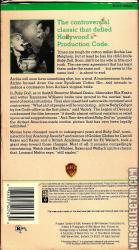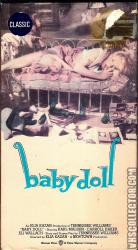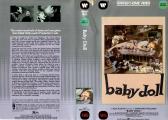Baby Doll
Catalog Number
34074
-
Primary Distributor (If not listed, select "OTHER")
Catalog Number
34074
Primary Distributor (If not listed, select "OTHER")
Release Year
Country
N/A (NTSC)
N/A | N/A | N/A
N/A | N/A
Baby Doll (1956)
Additional Information
Additional Information
Her role is raw electricity! Her portrayal is a sensation! CARROLL BAKER
From the author of "A Streetcar Named Desire"!
19 years old and married...but not really!
She's nineteen. She makes her husband keep away -- she won't let the stranger go.
She's nineteen. She's married two years -- quite a girl -- and not quite a woman...
Tennessee Williams' 27 Wagons Full of Cotton was the basis for this steamy sex seriocomedy. Karl Malden stars as the doltish owner of a Southern cotton gin. He is married to luscious teenager Carroll Baker, who steadfastly refuses to sleep with her husband until she reaches the age of 20. Her nickname is "Baby Doll", a cognomen she does her best to live up to by lying in a crib-like bed and sucking her thumb. Enter crafty Sicilian Eli Wallach (who, like supporting actor Rip Torn, makes his film debut herein), who covets both Malden's wife and business. Malden's jealously sets fire to Wallach's business, compelling Wallach to try to claim Baby Doll as "compensation." Heavily admonished for its supposed filthiness in 1956 (it was condemned by the Legion of Decency, which did more harm to the Legion than to the film), Baby Doll seems a model of decorum today--so much so that it is regularly shown on the straight-laced American Movie Classics cable service.
Baby Doll is a 1956 American black comedy[2] and drama film directed by Elia Kazan, and starring Carroll Baker, Karl Malden and Eli Wallach. The film also features Mildred Dunnock and Rip Torn. It was produced by Kazan and Tennessee Williams, and adapted by Williams from his own one-act play 27 Wagons Full of Cotton.[3][4][5] The plot focuses on a feud between two rival cotton gin owners in rural Mississippi; after one of the men commits arson against the other's gin, the owner retaliates by attempting to seduce the arsonist's nineteen-year-old virgin bride with the hopes of receiving an admission by her of her husband's guilt.
The film was controversial when it was released due to its implicit sexual themes, provoking a largely successful effort to ban it, waged by the Roman Catholic National Legion of Decency. Nevertheless, the film received multiple nominations for major awards and performed decently at the box office.[6] Kazan won the Golden Globe Award for Best Director and the film was nominated for four other Golden Globe awards, as well as four Academy Awards and four BAFTA Awards[7] awards, with Eli Wallach taking the BAFTA prize for "Most Promising Newcomer to Film."
The film is credited with originating the name and popularity of the babydoll nightgown, which derives from the costume worn by Baker's character.
Baby Doll was released in the United States on December 18, 1956, although the film had begun garnering controversy within the weeks before its release due to a promotional billboard on display in New York City, which depicted the now-iconic image of Baker lying in a crib, sucking her thumb.[6] Baker received a phone call from a journalist on a Sunday morning, saying "Your film Baby Doll has been condemned by the Legion of Decency and Cardinal Spellman has just stepped up to the pulpit and denounced it from St. Patrick's Cathedral. What have you got to say?"[12]
The film received a seal from the Motion Picture Code, but the Catholic Legion of Decency gave it a "C" ("Condemned") rating and called it "grievously offensive to Christian and traditional standards of morality and decency." They succeeded in having the film withdrawn from release in most U.S. theaters because of their objections over its sexual themes.[10] Variety noted that it was the first time in years that the Legion had condemned a major American film which had received the approval of the Code.[10]
Other religious figures became involved in the controversy surrounding the film, including Francis J. Spellman, the Catholic Archbishop of New York, who called it "sinful" and forbade Catholics in the archdiocese to see the film and James A. Pike of the Episcopal Cathedral of St. John the Divine in New York, who countered Spellman by pointing out that there was more "sensuality" in the film The Ten Commandments than there was in Baby Doll, and argued that "the church's duty is not to prevent adults from having the experience of this picture, but to give them a wholesome basis for interpretation and serious answers to questions that were asked with seriousness."[10] Others agreed with Pike, including the Catholic Archbishop of Paris and the head of the Catholic film Institute in the U.K., while the Catholic Bishop of Albany, New York also forbade Catholics to see the film, which the American Civil Liberties Union objected to as a violation of the First Amendment.[10]
According to Baker, she and everyone else who had worked on the film had "no idea" that the material would be perceived as controversial.[13] It was believed that the main reasons behind the backlash regarded the seduction scene between Baker and Wallach, in which his character successfully attempts to seduce and arouse her outside the farmhouse.[13] There was also speculation that, during their scene together on a swinging chair, that Wallach's character was touching Baby Doll underneath her dress due to the fact that his hands are not visible in the close up shot. According to both Baker and Wallach, the scene was intentionally filmed that way because Kazan had put heaters all around them because of the cold weather.[13]
The movie was banned in many countries, such as Sweden, due to what was called "exaggerated sexual content". The film was also condemned by Time magazine, which called it the "dirtiest American-made motion picture that had ever been legally exhibited".[14] Due in part to the attempts to have it banned or suppressed, the film was not a commercial success, although it performed decently at the box office in spite of the controversy. According to Kazan, however, the film did not make a profit.[9]
In retrospect, star Eli Wallach called the film "one of the most exciting, daring movies ever made", adding "People see it today and say, 'What the hell was all the fuss about?'"[6]
Release Date: December 16, 1956
Distrib: Warner Brothers
From the author of "A Streetcar Named Desire"!
19 years old and married...but not really!
She's nineteen. She makes her husband keep away -- she won't let the stranger go.
She's nineteen. She's married two years -- quite a girl -- and not quite a woman...
Tennessee Williams' 27 Wagons Full of Cotton was the basis for this steamy sex seriocomedy. Karl Malden stars as the doltish owner of a Southern cotton gin. He is married to luscious teenager Carroll Baker, who steadfastly refuses to sleep with her husband until she reaches the age of 20. Her nickname is "Baby Doll", a cognomen she does her best to live up to by lying in a crib-like bed and sucking her thumb. Enter crafty Sicilian Eli Wallach (who, like supporting actor Rip Torn, makes his film debut herein), who covets both Malden's wife and business. Malden's jealously sets fire to Wallach's business, compelling Wallach to try to claim Baby Doll as "compensation." Heavily admonished for its supposed filthiness in 1956 (it was condemned by the Legion of Decency, which did more harm to the Legion than to the film), Baby Doll seems a model of decorum today--so much so that it is regularly shown on the straight-laced American Movie Classics cable service.
Baby Doll is a 1956 American black comedy[2] and drama film directed by Elia Kazan, and starring Carroll Baker, Karl Malden and Eli Wallach. The film also features Mildred Dunnock and Rip Torn. It was produced by Kazan and Tennessee Williams, and adapted by Williams from his own one-act play 27 Wagons Full of Cotton.[3][4][5] The plot focuses on a feud between two rival cotton gin owners in rural Mississippi; after one of the men commits arson against the other's gin, the owner retaliates by attempting to seduce the arsonist's nineteen-year-old virgin bride with the hopes of receiving an admission by her of her husband's guilt.
The film was controversial when it was released due to its implicit sexual themes, provoking a largely successful effort to ban it, waged by the Roman Catholic National Legion of Decency. Nevertheless, the film received multiple nominations for major awards and performed decently at the box office.[6] Kazan won the Golden Globe Award for Best Director and the film was nominated for four other Golden Globe awards, as well as four Academy Awards and four BAFTA Awards[7] awards, with Eli Wallach taking the BAFTA prize for "Most Promising Newcomer to Film."
The film is credited with originating the name and popularity of the babydoll nightgown, which derives from the costume worn by Baker's character.
Baby Doll was released in the United States on December 18, 1956, although the film had begun garnering controversy within the weeks before its release due to a promotional billboard on display in New York City, which depicted the now-iconic image of Baker lying in a crib, sucking her thumb.[6] Baker received a phone call from a journalist on a Sunday morning, saying "Your film Baby Doll has been condemned by the Legion of Decency and Cardinal Spellman has just stepped up to the pulpit and denounced it from St. Patrick's Cathedral. What have you got to say?"[12]
The film received a seal from the Motion Picture Code, but the Catholic Legion of Decency gave it a "C" ("Condemned") rating and called it "grievously offensive to Christian and traditional standards of morality and decency." They succeeded in having the film withdrawn from release in most U.S. theaters because of their objections over its sexual themes.[10] Variety noted that it was the first time in years that the Legion had condemned a major American film which had received the approval of the Code.[10]
Other religious figures became involved in the controversy surrounding the film, including Francis J. Spellman, the Catholic Archbishop of New York, who called it "sinful" and forbade Catholics in the archdiocese to see the film and James A. Pike of the Episcopal Cathedral of St. John the Divine in New York, who countered Spellman by pointing out that there was more "sensuality" in the film The Ten Commandments than there was in Baby Doll, and argued that "the church's duty is not to prevent adults from having the experience of this picture, but to give them a wholesome basis for interpretation and serious answers to questions that were asked with seriousness."[10] Others agreed with Pike, including the Catholic Archbishop of Paris and the head of the Catholic film Institute in the U.K., while the Catholic Bishop of Albany, New York also forbade Catholics to see the film, which the American Civil Liberties Union objected to as a violation of the First Amendment.[10]
According to Baker, she and everyone else who had worked on the film had "no idea" that the material would be perceived as controversial.[13] It was believed that the main reasons behind the backlash regarded the seduction scene between Baker and Wallach, in which his character successfully attempts to seduce and arouse her outside the farmhouse.[13] There was also speculation that, during their scene together on a swinging chair, that Wallach's character was touching Baby Doll underneath her dress due to the fact that his hands are not visible in the close up shot. According to both Baker and Wallach, the scene was intentionally filmed that way because Kazan had put heaters all around them because of the cold weather.[13]
The movie was banned in many countries, such as Sweden, due to what was called "exaggerated sexual content". The film was also condemned by Time magazine, which called it the "dirtiest American-made motion picture that had ever been legally exhibited".[14] Due in part to the attempts to have it banned or suppressed, the film was not a commercial success, although it performed decently at the box office in spite of the controversy. According to Kazan, however, the film did not make a profit.[9]
In retrospect, star Eli Wallach called the film "one of the most exciting, daring movies ever made", adding "People see it today and say, 'What the hell was all the fuss about?'"[6]
Release Date: December 16, 1956
Distrib: Warner Brothers
Related Releases1
Catalog Number
34074
Primary Distributor (If not listed, select "OTHER")
Baby Doll (1956)
Release Year
Catalog Number
34074
Primary Distributor (If not listed, select "OTHER")
Catalog Number
34074









Comments0
Login / Register to post comments